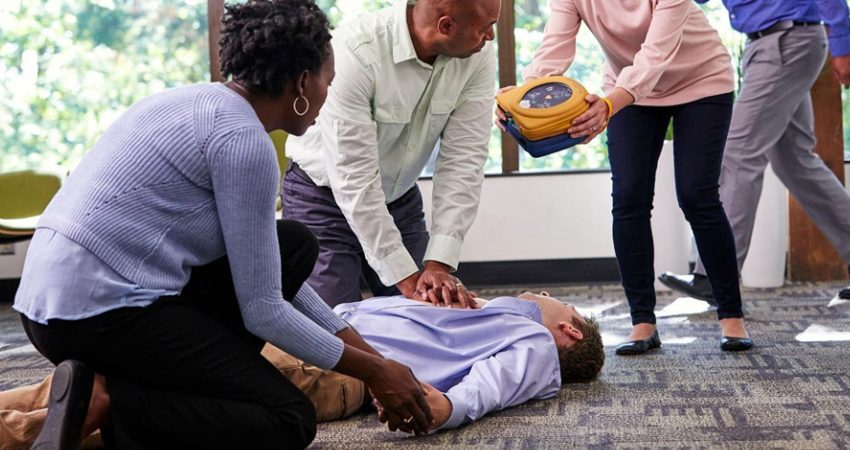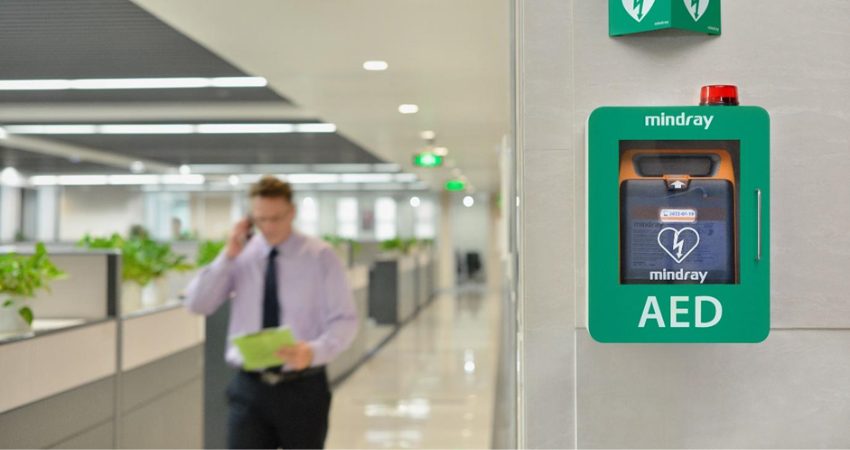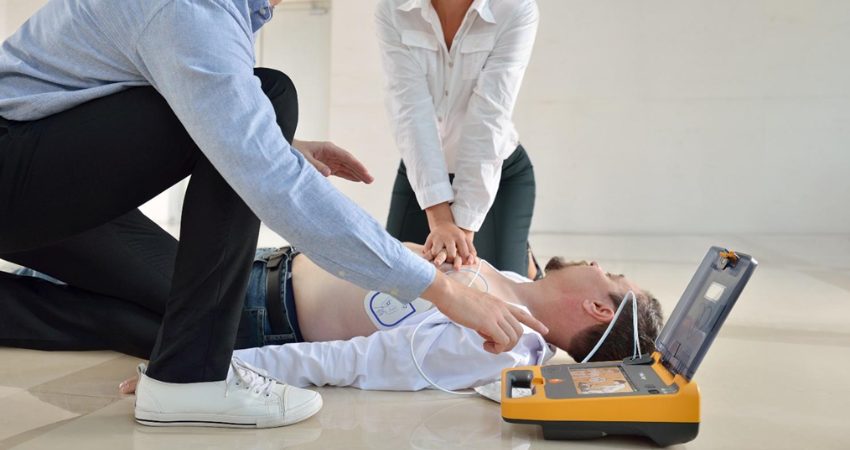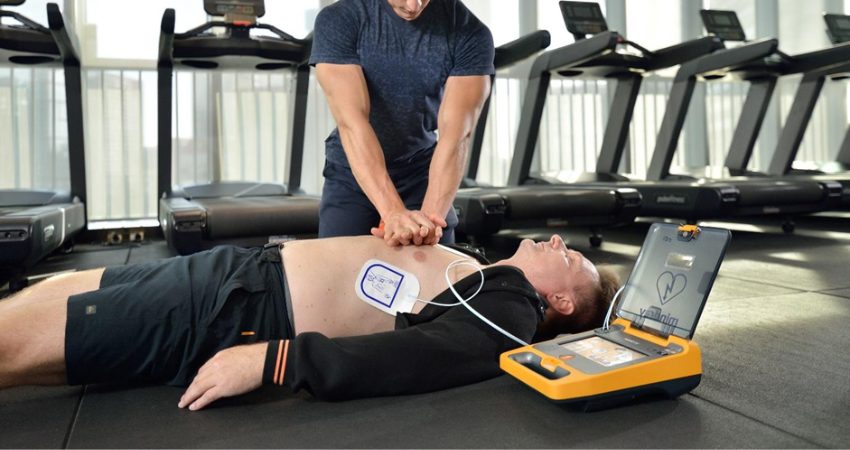Why Defibrillators Are An Important Workplace Asset
What are defibrillators / AEDs?
Defibrillators or AEDs (automated external defibrillators), are medical devices that are used to restore normal heart rhythm in people suffering from cardiac arrest. In an emergency, defibrillators can be the difference between life and death, so it’s no surprise that a lot of workplaces are opting to install them.
How do defibrillators work?
There are multiple types – such as implantable cardioverter defibrillators (ICDs), wearable cardioverter defibrillators (WCDs), semi-automatic AEDs and automated external defibrillators (AEDs) – however, this article will be discussing AEDs.
AED are devices that are designed to be easily used by non-medical professionals in cardiac emergencies. They check the heart’s rhythm and, if necessary, send a shock to restore normal rhythm.
Sticky pads with sensors, called electrodes, are attached to the chest of someone who is having cardiac arrest. The electrodes send information about the person’s heart rhythm to a computer in the AED. The computer analyses the heart rhythm to find out whether an electric shock is needed. If it is needed, the electrodes deliver the shock.
Do you need to have first aid training to use a defibrillator?
The short answer is no. AEDs are designed to be simple and easy to use, even for those without medical training. They typically include clear instructions and audio prompts to guide the user through the process of delivering a shock to the individual’s heart. Another useful feature is that many AEDs now include CPR coaching to ensure that the person providing the CPR is doing it correctly and effectively. You won’t be instructed to give a shock to the patient if it’s not required.
Why is it so important to have easily accessible defibrillators?
The answer to this is simple. The use of defibrillators significantly increases the survival rate of people who suffer from out-of-hospital cardiac arrest.
A scary statistic is that the UK survival rate for out-of-hospital cardiac arrests is only around 8%. (Interestingly, this is lower than in other developed countries.) The chances of survival are estimated to decrease by 10% each minute that a cardiac arrest sufferer goes without defibrillation.
In December 2022, the average UK ambulance response time to a life-threatening emergency was 10 minutes and 57 seconds. With this in mind, it’s unsurprising that only around 20% of out-of-hospital cardiac arrests are even treatable via defibrillation by the time an ambulance arrives.
The results of UK studies by the National Institute for Health and Care Research show that automated defibrillators significantly increase survival rates. Here’s a summary of their findings:
The survival rate of patients if a defibrillator had been attached:
- The median survival rate was 22% if attended to by any non-medical first responder.
- The median survival rate was higher following defibrillator attachment from bystanders at 32% than for dispatched firefighters or police at 12%
If the defibrillator had been attached to the patient and they had a shockable rhythm:
- The median survival rate was 40% if the defibrillator was attached by any non-medical first responder.
- The median survival rate was higher if the defibrillator was attached by bystanders at 53% compared with dispatched firefighters or police at 29%
Compared to the average 8% survival rate, these findings show how important AEDs are. Installing one in the workplace could literally save the life of an employee, visitor, student, not to mention your own.
If your business is in a high-traffic area, having a publicly accessible AED can also be a large benefit to your local community. There are apps and online directories that list the closest public AEDs, such as Heart Safe’s online map, so your business can really make a difference.
Are AEDs mandatory for my business type?
In the UK, it is not mandatory for any businesses to have AEDs installed but many have now chosen to install one. All schools in England are required to have at least one AED on their premises by the end of the academic year 2022/2023.
Purchasing a defibrillator for your business
Many businesses are committed to providing the safest possible workplace for their employees and guests. Quills can provide a variety of defibrillator machines, replacement parts and accessories – contact us for more information and advice or learn more here.
How often do defibrillator batteries need to be replaced?
This varies depending on the manufacturer but is typically every 3-5 years from the manufacturer’s production date.
How often do you need to change the pads?
Your defibrillator pads should have an expiry date on the back but the adhesive typically lasts two years. The pads can be purchased for adults, infants, or a set of both.
How to use a defibrillator
While these devices are designed to be easy to use, it’s still important to know how to properly operate one in case of an emergency. Each automatic defibrillator will have unique instructions, so make sure to review any documentation the device comes with and how to run a maintenance check. You can also have your office’s designated first aid officer learn how to operate it. Here is a brief overview of the process:
Step 1: Check for signs of life
Before using a defibrillator, it’s important to check for signs of life in the individual experiencing cardiac arrest. This includes checking for breathing, pulse, and responsiveness. If the individual is not breathing or has no pulse, it’s time to use the defibrillator.
Step 2: Turn on the defibrillator
Once you have determined that the individual is in cardiac arrest, turn on the defibrillator. It should have clear instructions and audio prompts to guide you through the process.
Step 3: Apply the pads
The defibrillator will come with pads that need to be applied to the individual’s bare chest. The pads will have clear instructions on where to place them. It’s important to make sure that the pads are properly positioned before continuing.
Step 4: Follow the audio prompts
The defibrillator will give you clear audio prompts to guide you through the process. Follow these prompts carefully and do not touch the individual while the defibrillator is analysing their heart rhythm.
Step 5: Deliver the shock
If the defibrillator determines that a shock is needed, it will prompt you to deliver the shock. Press the button to deliver the shock as instructed by the audio prompts.
Step 6: Perform CPR
After delivering the shock, it’s important to immediately begin performing CPR as directed by the defibrillator’s audio prompts. This will help to circulate oxygen-rich blood to the individual’s brain and other vital organs. You will also be prompted if more force is required for hand compressions.
Step 7: Repeat as needed
If the defibrillator determines that another shock is needed, repeat steps 4-6 as directed by the audio prompts.
In conclusion, defibrillators are life-saving devices that can provide critical care to individuals experiencing cardiac arrest. By having an AED installed and knowing how to properly use it, you can help to save a life in an emergency situation. It’s important to familiarize yourself with the defibrillator’s instructions and audio prompts and to always follow them carefully. Knowing where the closest AEDs are in locations you frequent could save someone’s life!
Remember, if any emergency situation does arise, your first call should always be 999 as they will have the training to guide you through CPR and the use of an automatic defibrillator.
If you have any further questions about installing a workplace defibrillator, send us an enquiry today or call 0208 256 5080 or view our range here.










